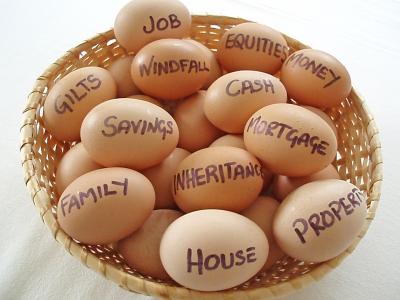In previous posts, we discussed how diversification--or investing in different kinds of assets--can reduce risk, and how we can use this strategy to protect ourselves in times of recession or economic crises. By employing diversification and "putting our eggs in different baskets" we can reduce the variability or fluctuations in the returns of our investment portfolio. But how exactly does diversification do this?
Let's take a look at this simple example. The following table shows the yields (in sacks per month) of four types of crops under different rainfall levels.
Crop Type | Rainfall Levels (inches) | |||
< 20 | 20 to 30 | 30 to 50 | > 50 | |
Wheat | 30 | 40 | 30 | 0 |
Oats | 60 | 20 | 10 | 0 |
Corn | 25 | 25 | 25 | 25 |
Soybeans | 0 | 30 | 50 | 90 |
In the table, we see that each of the four crops, taken in isolation, produce varying yields in different rainfall levels. For example, since oats thrive in a low rainfall environment, we can produce more sacks when the rainfall level is low than in very wet weather (60 sacks when the rainfall level is under 20 inches compared to zero sack when the rainfall level is more than 50 inches); the variability of oat yields can be described as ranging from zero to 60 sacks. The yield for wheat, in contrast, just ranges from zero to a maximum of 40 sacks. Since the yield for wheat has a narrower range than the yield for oats, we can say that wheat yields are less variable than the yield for oats. But among the four crops, we can see that corn provides the least variable yield, with 25 sacks regardless of the weather; because there is less variability and uncertainty in the yield of corn, and because there is no chance of zero yield whatever the weather is, we can say that corn is the safest or least risky crop.
So does this make corn our best option? Well, not necessarily: remember, we are not limited to planting just one crop since we can always divide our resources among several crops. For example, if we allocate our resources equally among wheat, oats, and soybeans, we can compute for our total yield by getting the average yield of the three crops under each rainfall level:
Rainfall < 20 inches: yield = (30 + 60 + 0)/3 = 30 sacks
Rainfall 20 to 30 inches: yield = (40 + 20 + 30)/3 = 30 sacks
Rainfall 30 to 50 inches: yield = (30 + 10 + 50) = 30 sacks
Rainfall > 50 inches: yield = (0 + 0 + 90))/3 = 30 sacks
We see here that by planting different crops, the variability of the yields is reduced to zero, and that under any rainfall condition, we yield 30 sacks: this is diversification in action. By planting crops that behave differently under the different rainfall scenarios, we were able to minimize risk. If the rainfall level is going to be low, we can rely on wheat and oats since these crops thrive in dry environments; if the weather is going to be wet, we can count on soybeans to deliver for us. So no matter what happens, no matter how the weather turns out, our bases are covered and we are assured of yielding 30 sacks of crops, which is even better than if we plant the equally safe corn.
We can think of these crops as different assets or investment vehicles (e.g., stocks, real estate, bonds, bank deposits, T-bills, etc.), the yields as the returns on our investment, and the variability of the yields as investment risk. Diversification can reduce the risk of our investments--without sacrificing returns--the same way it worked by planting wheat, oats, and soybeans. Using the example above, we can now identify two requirements for diversification to work:
1. Invest in several securities. Adding securities to our investment portfolio (collection of investments) reduces the risk of the portfolio as a whole.
2. Invest in securities that do not move together, or behave differently. Diversification will only work if the assets we invest in do not move in tandem under different scenarios or economic conditions. This relationship between asset returns is referred to as correlation. For diversification to work, we need to invest in assets that have negative or low correlation.








